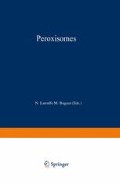Abstract
The most commonly used protein electrophoresis system today is the method described by Laemmli [2]. The Laemmli procedure, named sodium dodecylsulfate-polyacrylamide gel electrophoresis (SDS-PAGE), is a discontinuous system: the pretreated proteins are first concentrated in a stacking gel before entering the separating gel. Before electrophoresis, proteins are denaturated using SDS, an anionic detergent, that wraps around the polypeptide backbone and confers a negative charge to the polypeptide in proportion to its length. Proteins are also treated with a reducing agent such as 2-mercaptoethanol, which breaks disulfide bonds. After treatment, polypeptides are separated on the support gel, a Polyacrylamide matrix, on the basis of molecular weight by means of an electrical field in the presence of SDS. The major use of this system is to determine the molecular weight of polypeptides by running the gel silmutaneously with standard polypeptides of known molecular weights. A linear relationship exists between the log10 of the molecular weight of a polypeptide and its Rf (the distance from the limit between the stacking and separating gels to the polypeptide band, divided by the distance from the limit of the two gels to the front underlined by a low molecular weight dye).
Chapter PDF
Similar content being viewed by others
Keywords
These keywords were added by machine and not by the authors. This process is experimental and the keywords may be updated as the learning algorithm improves.
References
Harlow E, Lane D (1988) In “Antibodies, A laboratory manual.”, Cold Spring Harbor Laboratory, New York, USA
Laemmli, EK (1970) Cleavage of structural proteins during the assembly of the head of bacteriophage T4. Nature 227:680–685
Nemali MR, Usuda N, Reddy MK, Oyasu K, Hashimoto T et al. (1988) Comparison of constitutive and inducible levels expression of peroxisomal β-oxidation and catalase genes in liver and extrahepatic tissues of rat. Cancer Res 48:5316–5324
Towbin H, Staehelin T, Gordon J (1979) Electrophoretic transfer of proteins from Polyacrylamide gels to nitrocellulose sheets: Procedure and some applications. Proc Natl Sci USA 76:4350–4354
Van den Bosch H, Schutgens RBH, Wanders RJA, Tager JM (1992) Biochemistry of peroxisomes. Annu Rev Biochem 61:157–197
Editor information
Editors and Affiliations
Rights and permissions
Copyright information
© 1994 Springer-Verlag Berlin Heidelberg
About this chapter
Cite this chapter
Pacot, C. (1994). Immunoblotting of Peroxisomal Proteins with Monospecific Antibodies. In: Latruffe, N., Bugaut, M. (eds) Peroxisomes. Springer Laboratory. Springer, Berlin, Heidelberg. https://doi.org/10.1007/978-3-642-87807-7_3
Download citation
DOI: https://doi.org/10.1007/978-3-642-87807-7_3
Publisher Name: Springer, Berlin, Heidelberg
Print ISBN: 978-3-642-87809-1
Online ISBN: 978-3-642-87807-7
eBook Packages: Springer Book Archive




